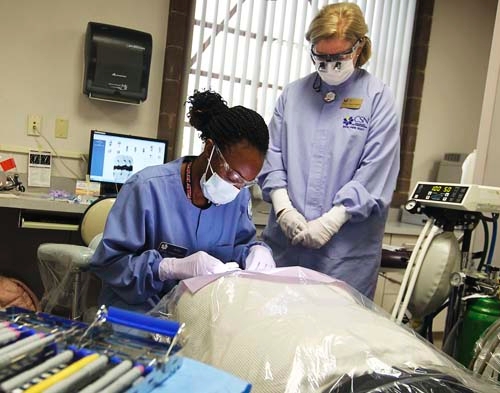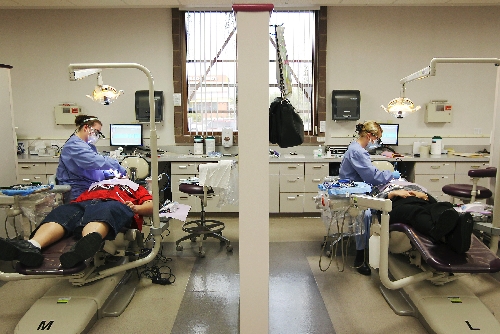Speedy service not always good service in dentistry




We all love speedy service. But we shouldn’t when it comes to our dental care. In tough times, all service industries are forced to watch expenses and get the most out of staff. Dental offices, unfortunately, are no exception. But a quick cleaning could mean cut corners and oral health problems down the road.
John Hunt, attorney for the Nevada State Board of Dental Examiners, has seen firsthand how the economy has affected dental offices. Unnecessary dental work is at a "rampant" level in the valley, he says. It’s the primary concern he deals with among the thousands of annual complaints that come into the board of dental examiners either as phone calls or in writing.
Hunt notes there are far fewer complaints about hygienists than dentists. But that’s not to say they don’t exist. And many patients may not realize the care they received wasn’t satisfactory until long after it happened, usually after trying a new dental office some six months later.
"That’s how you hear about it," he says. "They (patients) go to someone else and it’s a case of ‘They did what?’ "
Hunt highlighted a recent case in which a hygienist had a license taken away after admitting to doing 36 root paling and scaling procedures in a day. The standard, per the board of dental examiners, is 45 minutes to 60 minutes for one paling and scaling procedure.
"Sadly, greed perpetuates less-than-proper bedside manner," he adds.
Dr. Johnathan White, owner of Aesthetic Dentistry in the western Las Vegas Valley, says he sees his share of patients who describe questionable practices at other offices.
"Patients come in and tell me someone cleaned their teeth in 15 minutes. They’ll say, ‘I don’t even know if a dental hygienist saw me.’ And a lot of times they (a hygienist) probably didn’t," White says.
White describes a practice he refers to as "accelerated hygiene" that goes on in some dental offices. This is where an office will pair a hygienist with a dental assistant, the latter of which will simply polish the patient’s teeth, allowing the hygienist to move onto another cleaning. Some offices will have a hygienist seeing two to three patients within an hour as a result, he says.
"It’s not really illegal, but is it thorough? That would be a different question," he says.
White says he allows an hour for a dental hygienist to clean a patient’s teeth. If a patient doesn’t have periodontal disease or other major issues, a cleaning could be completed in 45 minutes, he adds. The state’s board of dental examiners recommends 45 minutes to one hour for a cleaning for its standard of care.
"I’m profitable enough that I don’t rush anything, ever," White says.
Shari Peterson, head of the dental hygienist program at the College of Southern Nevada, has also seen the economy’s effects on dentistry. Her program takes in 20 new students each year, down from 30 a few years ago.
That count has dropped partly because demand for the field has dropped. But a greater frustration for Peterson and her graduates also exists.
Recent graduates are finding some employers demanding a number of cleanings be done in a certain time period, Peterson says. Any cleaning done in less than 45 minutes "compromises infection control and patient education," Peterson says.
"My personal opinion is that students learn the standards of care and are taught ideal dentistry and dental hygiene. But when they get out into the real world, the practice dictates what procedure should happen in the office, and it all comes down to time and money," she adds.
Hunt says any sort of quota system set in a dental practice is considered "unprofessional conduct" by the state’s dental board, and dentists should beware if they are engaging in such practice.
Peterson understands that her school may encourage students to have standards that are difficult to maintain in a busy practice. But dental office staffs should still be making the effort.
"Nobody ever really completely maintains an academic practice," she says. "But there are some very good dentists and hygienists out there, too."
WHAT TO EXPECT
Although it may be difficult to understand everything a hygienist or dentist is doing during a cleaning and checkup, the American Dental Hygienists Association offers some "standards of practice" for hygienists, such as assessing a patient’s history; comprehensively examining the head and neck, including the oral cavity; performing a risk assessment; doing a dental hygiene diagnosis; and implementing a dental hygiene care plan.
Peterson simplifies the guidelines by letting her students know that education is a big part of the dental hygienist’s job.
"Hygienists really focus on the preventative aspects of dentistry. It also dovetails into medicine where they need to recognize certain medical conditions," she says. "A lot of times in appointments, teeth are scraped and polished and they didn’t tell you about problem areas. Unfortunately, you may end up having a cavity or losing a tooth if you have not been legally informed."
A hygienist should be reviewing medical history and overall general health, doing oral cancer checks and conducting probings for periodontal disease at every appointment, Peterson says. And, above all, hygienists should communicate their findings to patients.
Patients who smoke should expect a lecture. Peterson says hygienists should be building a rapport to try to understand if a patient is considering quitting.
"They (patients) should be going through tobacco counseling every time," she says.
Nutritional counseling is also a key role for hygienists. Avoiding sugary foods may seem like common knowledge. But when it comes to fluid consumption, there is much misinformation out there.
"Our society is so addicted to caffeine and power drinks. But there are many other things in caffeinated beverages, too. Diet drinks just have a different kind of sugar. Also, carbonation has a leaching effect on the teeth," Peterson says.
White’s approach to education also employs technology. For a first visit, he tells patients to expect a two-hour experience, one hour with the dentist, then an hour for the cleaning. He uses an oral camera to let patients see images of their mouths on a plasma- screen television.
"It’s fun for them to see what’s going on in the mouth. And it helps them understand why it is we’re doing what we’re doing," White says. "We don’t want to keep the patient in the dark. That’s not how they own the problem."
Patients at the College of Southern Nevada clinic will also find hygienists use a litmus strip to test saliva pH levels, which should be near 7, which is neutral, Peterson says. Although pH levels can fluctuate depending on the food eaten before an exam, getting a sense of the acidity/alkalinity of saliva is always a good tool for educating a patient when it comes to nutrition. If saliva is more acidic (a reading lower than 7), it can cause cavities because of demineralization of tooth enamel. Carbonated drinks and sugary foods can create a lower pH. Teeth can also become brittle if the pH is too alkaline.
"You may not have enough acidity to ward off the accumulation of bacteria," Peterson says.
Blood pressure should be checked at every appointment, too, Peterson adds, and especially before anesthesia is given. High blood pressure is linked to a high incidence of periodontal disease and other health problems, she notes.
PERIDONTAL DISEASE, QUESTIONS
A person with periodontal (gum) disease, which causes bone to retract from teeth, should expect a longer visit with the dental hygienist. With existing periodontal disease, a probe should be done every six months, as research has tied the disease to numerous other health problems. According to the ADHA, 95 percent of the roughly 24 million diabetes sufferers in the United States also have periodontal disease. The organization also points to strong evidence supporting heart disease having a tie to certain bacteria found in periodontal disease.
White says some patients with gum disease may need to see a hygienist every three months if their case is extreme. The best defense against the disease is proper flossing, he added.
There are questions a patient could ask to make sure all necessary checks and screens are being completed in an exam and cleaning. Asking a hygienist what the readings are for a periodontal probe is one good question, Peterson says. White says a periodontal pocket 3 millimeters deep or less is healthy; 4 millimeters and deeper is considered the beginning stages of periodontal disease. Deeper than 6 millimeters is a more severe case where actual bone loss has occurred.
White encourages patients to be straightforward with hygienists and ask them about their experience levels. He adds that patients should ask friends which dental office they use, why and how long their hygienists take with them.
"There should never be a reason for a dental office to become frustrated or angry when you ask them these things," White says. "It’s in your best interest."












